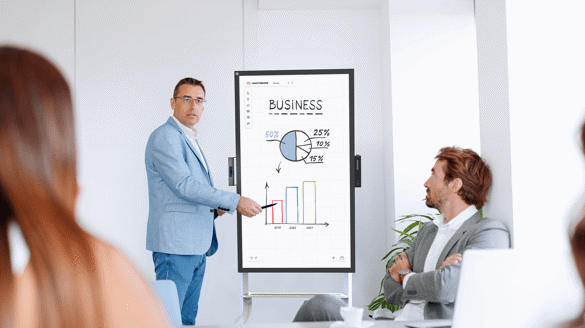The way we work is changing. The traditional meeting room is evolving steadily into a meeting space, as the concept of work takes on a more flexible meaning. We are also working more often with external individuals, calling in remotely or working on a project-by-project basis. Our meetings tend to be shorter, less formal, and with less planning.
The way we work today requires small, flexible, and agile meeting spaces for ad hoc meetings. It is essential that this new type of meeting space contributes to efficient and productive work sessions. Here are some tips for you to create your perfect meeting space.
The space
1. Pay attention to the physical elements
Good quality lighting and acoustics are crucial to the meeting room space. If the light in your meeting room is dim, harsh or lifeless, it is time to do something about it. After all, it sends the wrong messages to employees about the morale of your organization.
The same goes for poor acoustics. If you have an echo, a room that is not soundproof, or a significant amount of ambient noise, it is time to fix it. What’s the point of a meeting if the communication is not clear and precise?
2. Future-proof your business
Embed flexibility and agility into your meeting space. Build an infrastructure that allows frequent, streamlined upgrades, particularly where technology is concerned. Technology allows it so that there are so many unique and interesting ways in which individuals and organizations can collaborate, no matter what time zone they happen to be working in.
Your meeting space should be technologically advanced to ensure that you remain on the cutting edge of the market.
If this is not available, consider finding a meeting space more adjustable to becoming “future-proof”.

The tools
3. Invest in added-value tools
Only invest in tools that can help you to do what you currently do better and bring your business forward. It is essential to know exactly how the new tool can help you get your work done quicker and more efficiently.
You should focus on investing in some key tools that won’t simply be another aspect of your organization when it comes to meetings, but pay for itself and more thanks to the value that they bring to them.
4. Start and end your presentation on time
Minimize the set-up time for a presentation by using wireless presentation technology. This negates the need for the right cable or connection, especially when people bring their own devices.
Most wireless screen sharing devices can also let others take control of the presentation from their device, thus encouraging collaboration.
Meetings aren’t about how long they are - it’s about how productive they can be.
Make sure that you are not wasting any time when it comes to addressing concerns and going over talking points.

5. Keep your meeting seamless
During a meeting, we often use a wide variety of communication and collaboration tools and software. To run smooth and efficient meetings, you must make sure your tools are interoperable, so you can switch from one to another seamlessly.
This can help with overall time, and employees can focus on achieving goals quicker.
6. Keep it user-friendly
Make sure your tools are intuitive and straightforward to lower the threshold for daily use. New tools are often not welcomed and usually require having to overcome resistance.
Once your team is convinced that the tools are easy-to-use and will change the way they work for the better, they will become essential very fast.
If the meeting tools have too much of a learning curve, it can end up affecting deadlines and key metrics that will damage your reputation and revenue.
7. Choose an open video conferencing solution
Do you often work with remote team members or consultants? Consider investing in video conferencing tools such as Zoom, Starleaf or Skype for Business.
There is a diverse array of flexible videoconferencing platforms that makes collaboration with external partners very easy.

8. Use a cloud-based collaboration platform
Cloud-based software is accessible from any device with internet access, regardless of location. This allows you to work together with your remote team members on the same documents from anywhere, at any time and on any device.
9. Get more work done in meetings
Get immediate access to your files, whether it is on Google Drive or Microsoft Teams. Take notes and action points and save everything in your trusted place.
10. Make it shareable
Share your notes with stakeholders. This allows for a new level of trust and transparency that can help investors and others truly understand your priorities and objectives. When it comes to scheduling, you can also organize follow-up meetings and easily work from the saved files.
"Valuable information often gets lost after a brainstorm session. Collaboration displays solve this issue: using one medium you can save all your thoughts and messages and correlate them." - Marcell Coppens, Sr. Solutions Consultant at DEKOM Belgium
Conclusion
Long gone are the days where meeting spaces were one-size-fits-all. Today’s meeting spaces need to be flexible to accommodate a more dynamic, hands-on approach to meetings. It’s about a space where you can use the tools needed to have productive and transparent collaboration and communication.
To ensure your organization makes the right investment in meeting room technology that best meets the needs of individual employees and the organization, contact us or check out our solutions.
Written by: Muriel De Bruyne on Friday, August 13, 2021